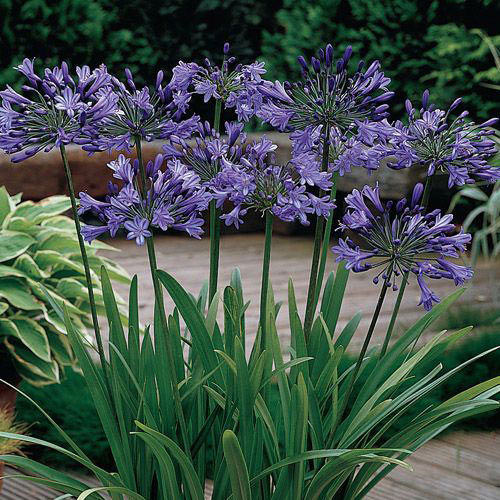Expanding Agapanthus: A Complete Overview to Beautiful Blooms
Expanding Agapanthus: A Complete Overview to Beautiful Blooms
Blog Article
Grasping the Art of Agapanthus Care: Vital Actions for Healthy And Balanced Development and Vibrant Blossoms
In the realm of gardening, the growing of agapanthus stands as a fulfilling undertaking for those who seek to nurture these stylish blooming plants. With their striking blooms and graceful foliage, agapanthus has actually captured the interest of garden enthusiasts worldwide. Nonetheless, attaining optimum development and vivid blooms calls for a nuanced approach that encompasses various essential steps. From selecting the best range to mastering pruning techniques, the journey towards cultivating flourishing agapanthus plants is diverse and holds the essential to unlocking the full capacity of these herb gems.

Selecting the Right Agapanthus Selection

When picking the best Agapanthus selection for your yard, take into consideration elements such as environment suitability, blossom shade, and development habit. In addition, consider the climate in your region to make certain the Agapanthus variety you pick can flourish in your details conditions. Understanding the development routine of various Agapanthus selections is vital for proper positioning within your yard.
Ideal Planting Problems
Considering the ideal ecological requirements is crucial for effective Agapanthus cultivation. Agapanthus grows in well-draining dirt with a slightly acidic to neutral pH degree. When growing, pick an area that gets complete sunshine to partial shade. In hotter environments, providing some afternoon color can protect against scorching of the fallen leaves. Agapanthus plants are delicate to cold temperature levels and ought to be secured from frost during winter season.
To make sure healthy development and vivid blooms, plant Agapanthus bulbs at a depth of about 2-4 inches and space them 8-12 inches apart. Mulching around the base of the plants aids maintain wetness and suppresses weed growth.
Watering and Feeding Tips
Maintaining correct moisture degrees and giving necessary nutrients are crucial elements in the treatment routine for Agapanthus plants. It is important to strike a balance when it comes to sprinkling Agapanthus. If overwatered, these plants favor consistently damp soil however are susceptible to root rot. Throughout the expanding season, water deeply when a week, guaranteeing the dirt is well-draining to stop waterlogging. In hotter climates or throughout periods of dry spell, more constant watering may be needed to keep the soil evenly damp. However, lower watering in the winter season to prevent water logged conditions.
Feeding Agapanthus is essential for promoting healthy and balanced development and prolific blooms. Apply a balanced plant food, such as a 10-10-10 formula, in the very early springtime as brand-new development arises. Repeat this application every 6-8 weeks throughout the growing period. Stay clear of excessive fertilizing, as it can cause lavish vegetation at the expenditure of blooms. Constantly follow the manufacturer's instructions for appropriate dilution and application techniques. By complying with these watering and feeding pointers, you can ensure your Agapanthus plants flourish and create lively, resilient flowers.
Trimming Strategies for Agapanthus
Trimming Agapanthus plants at the proper times and with appropriate techniques is critical for keeping their health and advertising optimal growth and blooming. The ideal time to trim Agapanthus look at this web-site is in late winter or very early spring prior to brand-new growth arises.
Deadheading spent blossoms can also redirect the plant's energy right into creating more blooms instead than establishing seeds. If you desire to accumulate seeds for breeding, leave some flowers to mature and completely dry This Site on the plant.
Bear in mind to use clean, sharp devices to make exact cuts and decrease the risk of presenting diseases. Agapanthus. Regular trimming will help maintain your Agapanthus looking healthy and neat while making sure a bountiful screen of stunning blossoms
Managing Usual Bugs and Diseases
After guaranteeing correct trimming techniques for Agapanthus, it is necessary to address typical pests and diseases that can affect the wellness and vigor of these plants. One common bug that impacts Agapanthus is the Agapanthus gall midget.
Additionally, Agapanthus plants can endure from root rot if they are planted in badly draining dirt. By being cautious and taking timely activity against parasites and illness, you can help your Agapanthus plants thrive and generate dynamic blooms. Agapanthus.

Final Thought
Finally, grasping the art of agapanthus care includes choosing the ideal variety, giving suitable planting problems, correct watering and fertilizing, appropriate pruning strategies, and resolving typical bugs and conditions. By adhering to these vital actions, you can make certain healthy development and lively blossoms for your agapanthus plants. read here Keep in mind to on a regular basis keep an eye on and maintain your plants to advertise their general well-being and long life.
To make sure healthy development and vivid blooms, plant Agapanthus bulbs at a deepness of concerning 2-4 inches and area them 8-12 inches apart. By following these watering and feeding pointers, you can guarantee your Agapanthus plants flourish and create lively, long-lasting flowers.
One usual pest that affects Agapanthus is the Agapanthus gall midge. Additionally, Agapanthus plants can suffer from origin rot if they are planted in inadequately draining dirt. By adhering to these vital actions, you can ensure healthy development and vivid flowers for your agapanthus plants.
Report this page